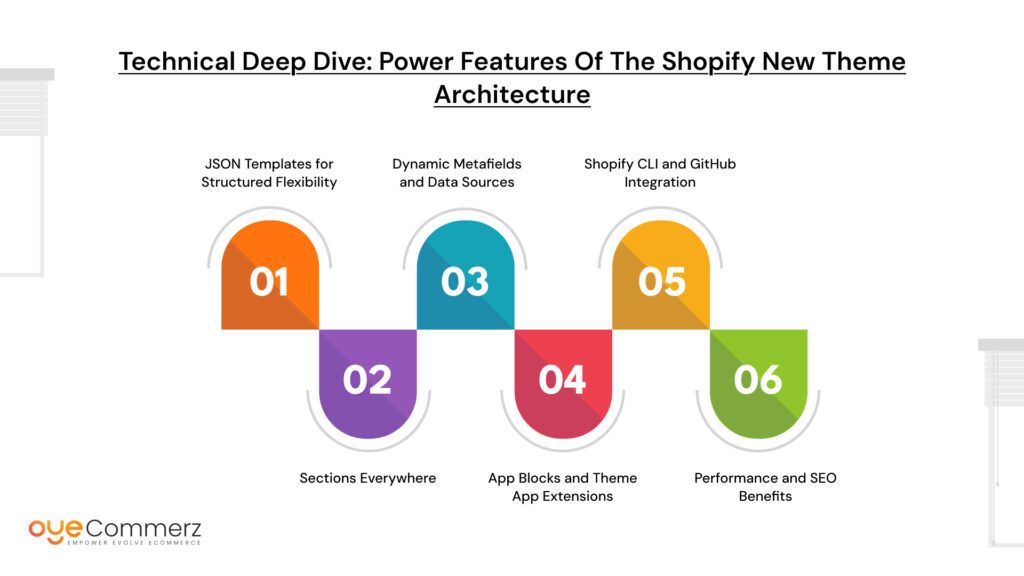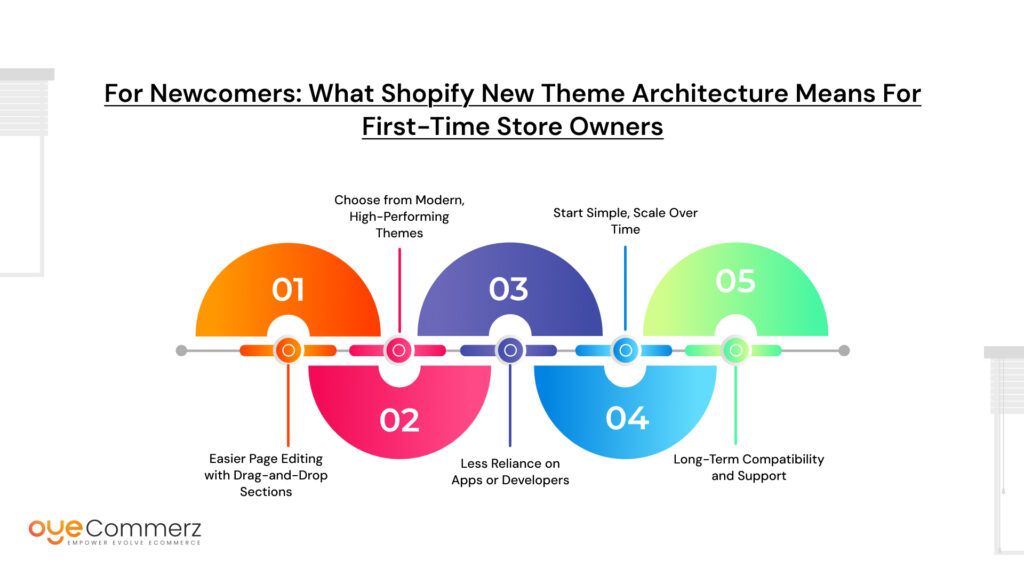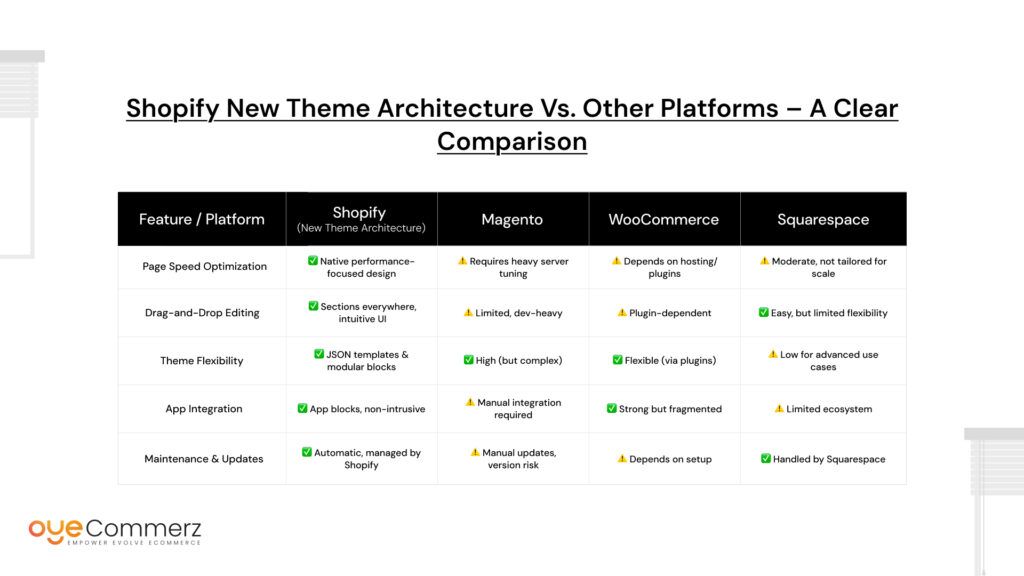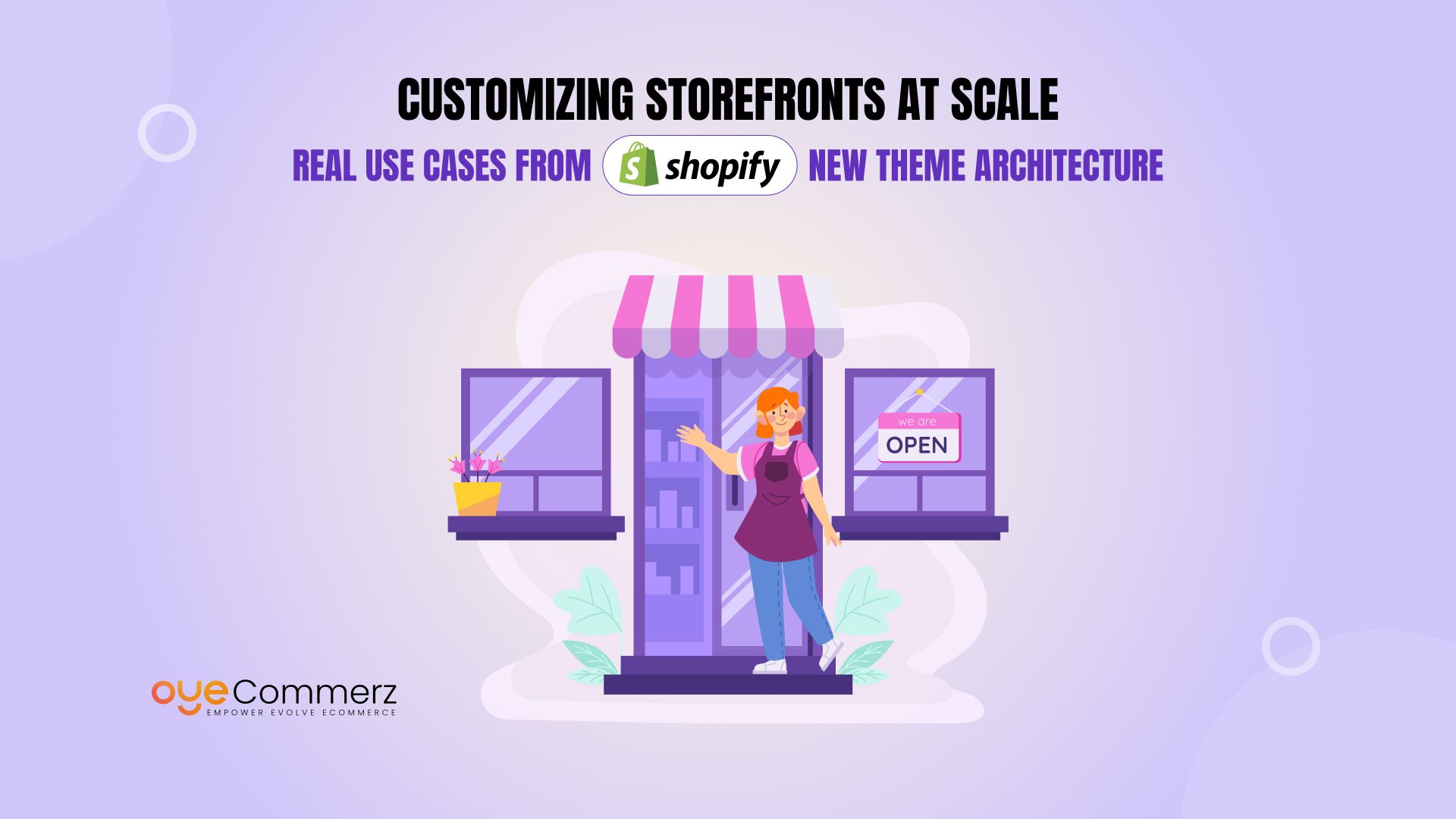Scaling a storefront used to mean sacrificing speed, consistency, or creativity, sometimes all three. As e-commerce brands grow, they often face a frustrating roadblock: rigid theme structures that can’t keep up with evolving design needs and rising customer expectations.
According to Shopify’s 2024 data, merchants who upgraded to the Shopify New Theme Architecture saw up to 30% faster page loads and 20% higher conversion rates, simply by switching to more flexible, modular designs.
The problem? Most traditional themes weren’t built to support scale. Businesses juggling multiple product categories, seasonal campaigns, or rapid growth often find themselves tangled in custom code and performance issues.
This is where Shopify New Theme Architecture changes the game. Built for customization at scale, it empowers developers and merchants alike to build faster, cleaner, and more dynamic storefronts without the technical debt.
Whether you’re a solo founder launching your first store or a fast-growing brand managing multiple product lines, understanding Shopifys new theme structure could be your biggest competitive advantage.
In this blog, we’ll explore how the new architecture works, real-world examples of brands customizing at scale, and how you can leverage this framework to future-proof your online business.
Table of Contents
ToggleWhat Is Shopify New Theme Architecture?
The Shopify New Theme Architecture, also known as Online Store 2.0, is a major update to how themes work on Shopify. It was designed to give merchants more control, flexibility, and performance without relying heavily on developers.
In the past, customizing a Shopify store often meant editing theme code directly or installing several third-party apps just to achieve basic layout changes. Now, with the new architecture, much of this can be done visually, faster, and more efficiently.
Here’s what sets it apart:
1. Sections Everywhere
Previously, sections were only available on the homepage. Now, with the new architecture, you can add sections to any page, product pages, collections, blog posts, and more. This means more customization, with less code.
2. JSON Templates
Themes now use JSON-based templates instead of Liquid-only layouts. JSON makes it easier to define the structure of a page and control which sections appear where, enabling merchants to update content without touching the code.
3. App Blocks
Instead of hardcoding app features into a theme, apps can now be added as drag-and-drop blocks. This reduces theme bloat and simplifies app integration.
4. Metafields and Dynamic Content
You can now add extra fields (like delivery times, specifications, or unique descriptions) without custom code. These metafields are built into Shopify and support dynamic content, making it easier to scale content for hundreds of products or pages.
5. Developer-Friendly Toolkit
For developers, Shopify offers powerful tools like the Shopify CLI, GitHub integration, and version control to manage themes efficiently. These features reduce the risk of errors and make collaboration smoother.
In short, the Shopify New Theme Architecture makes it easier for both new and experienced users to build fast, flexible, and scalable storefronts that meet the demands of modern online shoppers.
Why Storefront Customization at Scale Matters
As your business grows, so do the complexities of your storefront. What works for a small catalog with a single audience segment often falls short when you’re managing hundreds of SKUs, serving diverse customer profiles, or running multi-channel campaigns. Without the right theme structure, scaling your storefront can feel like patchwork, slow, expensive, and unsustainable.
This is where the Shopify New Theme Architecture plays a vital role.
The Problem with Traditional Themes
Older themes often rely on hardcoded templates and limited flexibility. Making a layout change across multiple product pages or running localized promotions could require hours of developer time or duplicate templates, resulting in bloated code and inconsistent branding.
Modern E-commerce Demands Agility
Today’s online shoppers expect fast, personalized, and seamless experiences across every touchpoint. Whether it’s mobile-first design, customized product recommendations, or dynamic landing pages your storefront needs to adapt quickly.
A study by Deloitte found that 38% of consumers will abandon a website if they find it unattractive or hard to navigate, and load delays of just one second can reduce conversions by up to 7%.
Shopify New Theme Architecture Solves This
With modular design, JSON templates, and dynamic app blocks, Shopify enables merchants to scale content, layout, and features without compromising performance or needing a full-time developer on call. You can:
- Deploy changes globally or locally in minutes
- Personalize pages based on collections, vendors, or campaigns
- Integrate apps cleanly without altering core theme files
- Maintain speed and SEO standards across all pages
The result? A storefront that evolves with your business, not against it.
Whether you’re running flash sales, launching seasonal collections, or expanding internationally, the Shopify New Theme Architecture gives you the control and scalability you need to move fast without breaking your store.
Technical Deep Dive: Power Features of the Shopify New Theme Architecture

For developers and technical teams, the Shopify New Theme Architecture unlocks a more scalable, modular, and performance-oriented foundation for building storefronts. Whether you’re customizing at the theme level or integrating advanced apps, this architecture is built for efficiency and long-term growth.
Here’s a closer look at the core technical features that power Shopify’s most flexible storefronts:
1. JSON Templates for Structured Flexibility
Instead of using Liquid-only files for page layouts, the new architecture introduces JSON templates. These templates define the structure of a page including which sections appear and in what order without mixing layout logic and business logic.
Why it matters:
- Cleaner separation of content and logic
- Easier updates without code changes
- Ideal for non-developers using the theme editor
2. Sections Everywhere
Previously limited to the homepage, sections can now be used across all page types, product pages, collections, blogs, and custom templates.
Key benefits:
- Component-based design makes pages more modular
- Reusable content blocks reduce duplication
- Faster editing directly in the Shopify Admin
3. Dynamic Metafields and Data Sources
Metafields are now integrated natively and can be surfaced directly in templates via dynamic sources. No third-party apps or custom Liquid code are needed.
Use cases:
- Display custom product specs
- Show delivery timelines or badges
- Link unique blog content to collections
4. App Blocks and Theme App Extensions
Instead of inserting app code manually into theme files, developers can now leverage theme app extensions and app blocks that plug directly into JSON templates.
Why it improves scalability:
- Reduces code conflicts and theme bloat
- Allows merchants to move, hide, or reorder app features from the UI
- Streamlines updates without breaking the layout
5. Shopify CLI and GitHub Integration
The development workflow has been modernized with tools like the Shopify CLI, which simplifies local development, theme previews, and deployments. GitHub integration ensures version control and collaborative development are built-in.
Technical gains:
- Faster testing and debugging
- Safe theme versioning
- Supports modern dev workflows and CI/CD
6. Performance and SEO Benefits
Themes built on the Shopify New Theme Architecture are optimized for speed and accessibility. Cleaner code, minimal app interference, and structured data improve site performance, a key factor in Google’s Core Web Vitals.
Result:
- Better rankings
- Faster load times
- Higher conversion rates
The Shopify New Theme Architecture isn’t just an update, it’s a framework designed for sustainable growth. Whether you’re developing in-house or through a Shopify Partner agency, this architecture delivers both control and flexibility at scale.
For Newcomers: What Shopify New Theme Architecture Means for First-Time Store Owners

If you’re just starting your e-commerce journey, hearing terms like JSON templates, metafields, or modular layouts might sound overwhelming. But the truth is, the Shopify New Theme Architecture is designed to make things easier not more complicated.
Shopify rebuilt its theme system not just for developers or large brands, but also for new merchants who want flexibility without needing to write a single line of code.
Here’s why it matters if you’re just getting started:
1. Easier Page Editing with Drag-and-Drop Sections
With Sections Everywhere, you can customize your homepage, product pages, and more by simply dragging and dropping content blocks. Want to add testimonials, videos, or special offers? You can do it all without touching the code.
2. Choose from Modern, High-Performing Themes
Themes built on the Shopify New Theme Architecture Dawnare mobile-optimized, fast, and easy to customize. These themes are ready out of the box and scalable as your business grows.
3. Less Reliance on Apps or Developers
With native support for dynamic content like product highlights, shipping info, or FAQs through metafields, you won’t need extra apps or custom code to get the features you want. This keeps your store simple, lightweight, and easier to manage.
4. Start Simple, Scale Over Time
You don’t need to launch with every feature. The Shopify New Theme Architecture is modular, meaning you can start with a clean foundation and add complexity later whether that’s custom landing pages, advanced filtering, or multilingual support.
5. Long-Term Compatibility and Support
Themes built on this architecture are future-ready. As Shopify continues to release updates, you won’t be left behind. That means fewer headaches down the road and more time focusing on growing your business.
Whether you’re selling your first product or testing the waters with a side hustle, starting with the Shopify New Theme Architecture gives you a strong, flexible foundation to build and grow your story without needing a developer on speed dial.
Shopify New Theme Architecture vs. Other Platforms – A Clear Comparison

Choosing the right e-commerce platform isn’t just about features it’s about long-term flexibility, performance, and ease of use. With the Shopify New Theme Architecture, Shopify has created a system that adapts to your business, no matter its size or complexity.
So how does it stack up against other popular platforms like Magento, WooCommerce, and Squarespace?
Here’s a side-by-side comparison to help you make an informed decision:
Why Shopify Leads the Way
The Shopify New Theme Architecture is the only solution in this comparison that combines advanced customization with ease of use making it a fit for both early-stage merchants and enterprise-level brands. Unlike platforms that trade speed for complexity or design for simplicity, Shopify delivers both.
If you’re looking for a platform that supports your growth without slowing you down, Shopify offers the best balance of flexibility, performance, and user experience.
Migration Made Easy: Why Now’s the Time to Switch to Shopify
If you’re currently running your store on platforms like Magento, WooCommerce, BigCommerce, or Squarespace, you’ve likely faced challenges with performance, limited design control, or overly complex customization. As your business grows, those limitations only become more costly.
The Shopify New Theme Architecture offers a solution that’s fast, scalable, and built for the demands of modern e-commerce. With advanced features like modular templates, dynamic content, and app integrations that don’t slow your site down, this architecture isn’t just a step forward it’s a competitive edge.
Why Migrate Now?
- Faster Page Loads: JSON templates and cleaner code reduce load time significantly.
- Improved SEO: Built-in schema, optimized metadata, and mobile-first performance support better rankings.
- Easier Design Updates: Customize layouts and product pages without needing a developer.
- Reliable Support: Shopify’s ecosystem includes 24/7 support, extensive documentation, and a large app marketplace.
Partner with Experts: Migrate to Shopify with Oyecommerz
At Oyecommerz, we specialize in helping brands make a seamless transition to Shopify Preserving data, improving performance, and customizing themes to match your business goals.
Our Shopify migration services include:
- Full migration from Magento, WooCommerce, Squarespace, and other platforms
- Theme setup or rebuild using the Shopify New Theme Architecture
- SEO retention and URL redirection strategy
- Performance optimization and mobile-first design
- Post-launch support and maintenance
Contact to Migrate your Site to Shopify Now
Conclusion
The demands of modern e-commerce aren’t slowing down. Whether you’re a growing DTC brand, an enterprise business managing multiple product lines, or a first-time store owner, your storefront needs to be flexible, fast, and easy to maintain.
That’s exactly what the Shopify New Theme Architecture delivers.
From “sections everywhere” to app blocks, JSON templates, and performance-optimized code, this architecture is designed for growth. It helps you manage complexity without compromising speed, launch campaigns faster, and deliver consistent experiences across every page all while giving developers and non-developers more control.
If you’re still relying on outdated platforms or rigid theme structures, now is the time to make a change with OyeCommerz.
Frequently Asked Questions
Shopify’s New Theme Architecture (Online Store 2.0) introduces modular design using JSON templates, sections on every page, app blocks, and dynamic content. These features allow merchants to customize storefronts at scale—without relying heavily on developers—while maintaining fast load speeds and responsive design
JSON templates separate layout from logic, allowing faster rendering and easier updates across pages. This improves Shopify storefront performance by reducing code redundancy, enabling dynamic content management, and enhancing SEO through lean, structured pages.
Yes. With a Shopify migration partner like Oyecommerz, you can migrate from Magento to Shopify while preserving SEO through proper URL redirection, metadata transfer, and performance optimization using the Shopify New Theme Architecture.
“Sections Everywhere” allows users to add, remove, or rearrange content blocks on any page—products, collections, blogs—without touching code. It gives merchants full design flexibility and supports storefront scaling without developer bottlenecks.
Shopify’s architecture offers faster load times, better scalability, and cleaner app integration compared to WooCommerce or Squarespace. Features like app blocks, native metafields, and JSON templates make Shopify more reliable and performance-driven for large and growing online stores.




